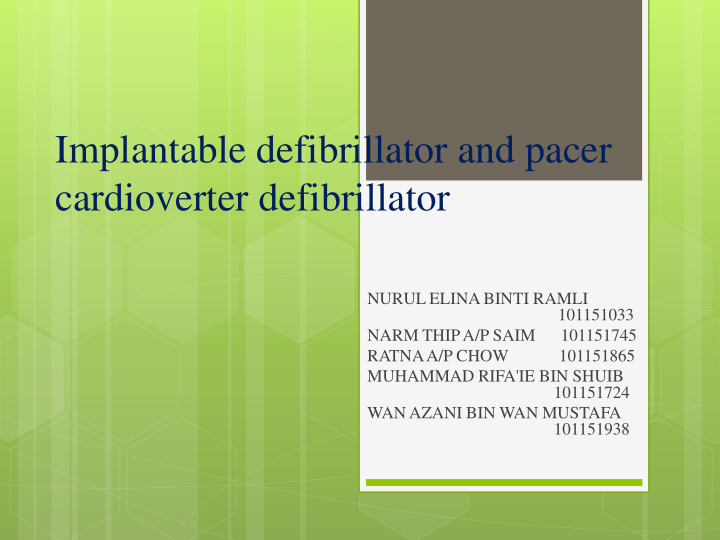



Implantable defibrillator and pacer cardioverter defibrillator NURUL ELINA BINTI RAMLI 101151033 NARM THIP A/P SAIM 101151745 RATNA A/P CHOW 101151865 MUHAMMAD RIFA'IE BIN SHUIB 101151724 WAN AZANI BIN WAN MUSTAFA 101151938
Implantable Defibrillator
Implantable Defibrillator An implantable defibrillator or implantable cardioverter defibrillator (ICD) is a device that is implanted under the skin of patients that are at risk ofsudden cardiac death due to ventricular fibrillation. The rudiments of cardiac arrhythmia detection and treatment are incorporated into the implantable device. The device was designed primarily to deal with ventricular fibrillation. Its current use has however extended to include atrial and ventricular arrhythmias as well as the ability to perform biventricular pacing in patients with congestive heart failure and to pace should there be any marked bradycardia.
What is an ICD (Implantable Cardioverter Defibrillator)? An ICD (implantable cardioverter defibrillator) is an electronic device that constantly monitors your heart rhythm. When it detects a very fast, abnormal heart rhythm, it delivers energy to the heart muscle. This causes the heart to beat in a normal rhythm again.
Why is an ICD needed? Ventricular tachycardia and ventricular fibrillation are two life-threatening heart rhythms that cause the heart to beat very fast. These conditions can be fatal if not treated immediately. Your doctor has recommended that you recieve an ICD because you have had at least one episode of these heart rhythms or are at high risk of developing these types of heart rhythms.
Who needs an ICD? An ICD may be recommended for people who: Had a prior episode of sudden cardiac arrest. Had a prior episode of ventricular fibrillation. Had at least one episode of ventricular tachycardia. Had a prior heart attack and have an increased risk for sudden cardiac arrest or sudden cardiac death. Have hypertrophic cardiomyopathy.
How does an ICD Work? The ICD monitors the heart rhythm, identifies abnormal heart rhythms and determines the appropriate therapy to return your heartbeat to a normal heart rhythm. Your doctor programs the ICD to include one or all of the following functions: Anti-tachycardia pacing (ATP) – When your heart beats too fast, a series of small electrical impulses are delivered to the heart muscle to restore a normal heart rate and rhythm. Cardioversion – A low energy shock is delivered at the same time as your heartbeat to restore a normal heart rhythm. Defibrillation – When the heart is beating dangerously fast, a high-energy shock is delivered to the heart muscle to restore a normal rhythm. Bradycardia pacing – When the heart beats too slow, small electrical impulses are sent to stimulate the heart muscle to maintain a suitable heart rate.
Types of ICDs
Pacer- Cardioverter- Defibrillator
PCD can be electronically programmed to deliver: * small, swift, "pacing" electrical impulses to restore regular beating to a heart whose rate is too slow (bradycardia) or too rapid (tachycardia) * stronger "cardioversion" shocks to restore normal rhythm when pacing doesn't stop the irregularity * a high-energy "defibfrillation" shock to restart the heart when the PCD detects heart fibrillation, or quivering.
Principle The PCD has three main parts: the pulse generator, wire leads, and an external programmer. The pulse generator, about the size of a cassette tape, is implanted under the skin or muscles of the abdomen. It contains a computer and battery that monitor the heart rhythm and deliver electrical stimuli when necessary. Several wire leads, which carry the electrical impulses, connect the pulse generator to the surface of the heart. The external programmer allows the doctor to fine-tune the pulse generator to the patient's needs. The programmer's memory bank stores facts, such as the number, types and success of heart-rhythm treatments the patient has received and a record of what the heart was doing during the most recent abnormal episode.
TECHNICAL ASPECTS The model 72 1 7B: PCD delivers monophasic shocks through three (or sometimes only two) electrodes. The principal internal lead is a 10.5-F coaxial cable, which is introduced through a cutdown over the cephalic vein. The second intravenous lead is a 6.5-F braided cable that has only defibrillatory function. It is introduced into the subetavian vein with the Seldinger technique. The third electrode consists of concentric platinum-coated alloy wire coils embedded in a polyurethane patch, which is implanted subcutaneously over the pectoral muscle or over the cardiac apex.
PCD leads in vitro. Radiograph shows the 10.5-F right ventricular lead (thick wire), 6.5-F intravenous lead (thin wire), and oval subcutaneous patch electrode. The 10.5-F lead has a screw electrode (solid arrow) for sensing and bipolar pacing and an anodal ring electrode (arrowhead) for sensing. Both intravenous leads have a platinum-iridium coil electrode (open arrows) for cardioversion or defibrillation.
THANK YOU FOR LISTENING…
Recommend
More recommend